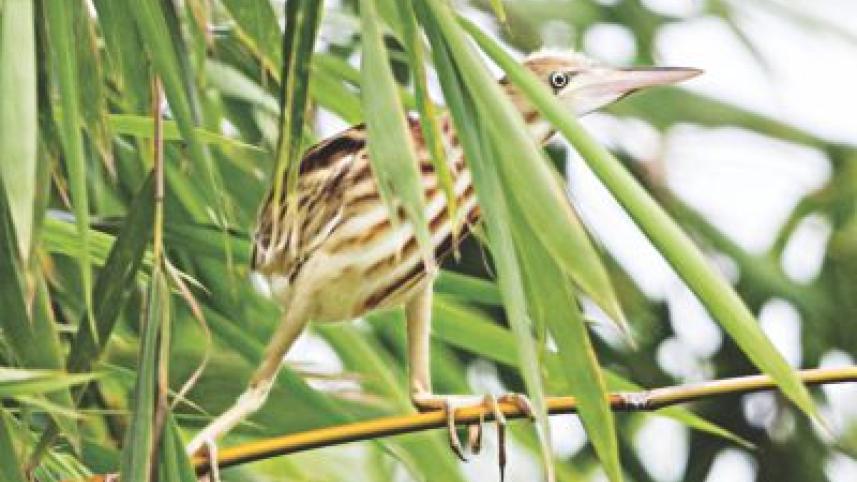Bitterns of Bangladesh

Two and a half years ago on a cool winter morning I stood at the edge of a fish pond in Hail Haor, a wetland near Moulvi Bazar. The sun had burned off the fog, leaving a clear day. The pond was large with a dense mix of aquatic plants growing around its edges. These plants – including water lily, water hyacinth and lotus – created a bushy green cover several feet wide encircling the lake's water. I was watching some whistling ducks (shorali) on the water when I was startled by a loud rustling noise very close. A black bird, similar in shape to a pond heron (kani boga) but smaller, shot out of the plant cover in front of me. I was able to get one or two quick photographs before it dived back into the plants and disappeared. I waited in vain for it to emerge from hiding.
Later, I showed the photographs to eminent birder Enam Ul Haque who confirmed that it was a rare black bittern.
Bangladesh has four species of bitterns: black, cinnamon, yellow and (the extremely rare) Eurasian bittern. They belong to the bird family Ardeidae. The same family includes egrets and herons (the bok and its relatives) and bitterns wear the same general look including a long pointed beak and tall skinny legs. However, in my experience, bitterns are very shy and secretive.
After the black bittern it was a long while before I saw another bittern: two weeks ago to be precise. In a remote part of Purbachol, on a small plot of trees flanked on both sides by bamboo groves, I was, once again, looking at another bird when movement in a jackfruit tree caught my eye. Perched on a big branch was what looked like a pond heron but smaller, and I immediately thought of bitterns. The bird was shy and as soon as it saw me it flew up to the top of an adjacent bamboo tree. There it clung to the thin trunk, swaying in the wind. I could clearly see the crest of feathers on its head and the streaks on the breast that characterize female yellow bitterns. High up, it furtively made its way through several bamboos. After allowing me some half-concealed poses, it flew off to land on another bamboo several hundred yards away.
I saw cinnamon bitterns in Purbachol several times, but always momentarily. I know where some of them live – among the water plants in lakes – but once they see me they dive into the bushes and stay out of sight. Some years ago I saw and photographed a cinnamon bittern in a Sylhet village, but since then every cinnamon bittern I have encountered flew before I could get a good photograph.
Bitterns get their food from water and mud. They hunt stealthily, particularly in marshy areas, looking for small fish, frogs and other small prey. One reason they are hard to spot is because they come out at dawn or dusk.
In flight, the cinnamon bittern looks reddish and the yellow bittern has a wide black band at wing's edge. This is how you tell them apart from the more common pond heron. To find bitterns is almost a stroke of luck. While you look for them in wetlands, fish ponds or rice paddies, stealth will be your best friend.
www.facebook.com/ikabirphotographs or follow ihtishamkabir on Instagram



 For all latest news, follow The Daily Star's Google News channel.
For all latest news, follow The Daily Star's Google News channel.
Comments